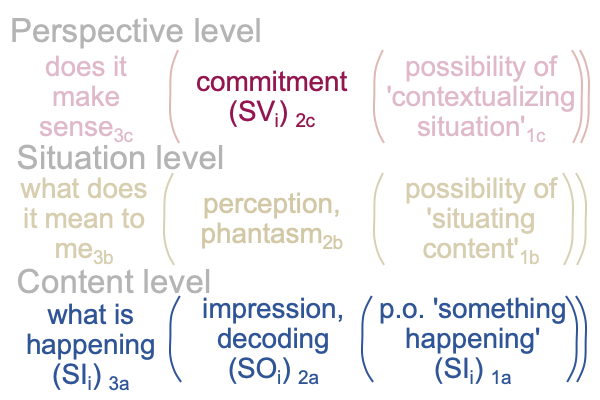0300 I am still on my way to delving into the brain tissue.
What resides in the neuroanatomy of the human brain?
An interventional sign-relation.
In a sign-relation, a sign-vehicle (SV) stands for a sign-object (SO) in regards to a sign-interpretant (SI).
For the interventional sign-relation, commitment2c (SVi) stands for a species impressa2a (SOi) in regards to what is happening3a operating on the potential of ‘something happening’1a (SIi).
0301 Here is a picture, using the scholastic interscope for how humans think.

The elements of the interventional sign-relation are explicitly labeled.
0302 Of course, the interventional sign-relation is the most difficult of the sign-relations in the scholastic interscope.
To start, even though commitment2c serves as a sign-vehicle, one cannot taste, smell, touch, hear or see it2c.
0303 One of the odd features of an intervention comes to mind. When an intervention occurs, one never really know where it is coming from2c. Sometimes, someone will offer an explanation for an intervention in order to inform others and justify actions, such as in the following statement.
I had to apply the Heimlich maneuver, grampa was choking on that brussels sprout.
0304 More often, information and justification are presupposed when a witness relates her impression of the event.
I was shocked and horrified when an entire brussels sprout shot out of the old man’s mouth!
0305 For the most part, people assume that what they think starts with a kind of impression, and that impression often contains crucial messages that are instantly decoded.
Yeah, the grandfather is eating and he starts wheezing and acting like something is stuck in his windpipe. Then someone shouts, “He’s choking!” And, everyone freaks out, except for the one person who saves the day.
0306 So, for almost all the witnesses, the old man chokes on a brussels sprout2a at dinner3a and someone at the table saves the day by applying the Heimlich maneuver1a.
In the format of the content-level nested form, the normal context of dinner3a brings the actuality of the elderly man choking on a brussels sprout2a into relation with the potential of someone nearby applying the Heimlich maneuver1a.
0307 Now, someone else at the table, an expert on Julian Jaynes as he is currently interpreted in 2025, after witnessing the entire event, makes an odd comment to the person sitting next to him.
He says, “The hero only applied the Heinrich maneuver because an auditory hallucination told him to do so.”
